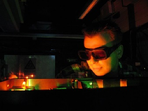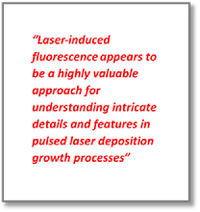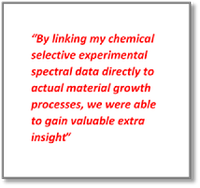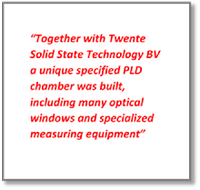 In this thesis the internal plasma dynamics and chemistry is studied as used in pulsed laser deposition (PLD). A spectroscopic spatiotemporal mapping of the plasma plume was realized. ‘In growing deposited layers complex process parameters are at stake,’ says Kasper Orsel. ‘We inspected the plasma in a direct way.’
In this thesis the internal plasma dynamics and chemistry is studied as used in pulsed laser deposition (PLD). A spectroscopic spatiotemporal mapping of the plasma plume was realized. ‘In growing deposited layers complex process parameters are at stake,’ says Kasper Orsel. ‘We inspected the plasma in a direct way.’
The fluency of the ablation laser and the composition of the background gas and its pressure, are key factors in these film growth processes. For the inspection, a combination of laser-induced fluorescence (LIF) and absorption spectroscopy (AS) was chosen. ‘LIF enables the detection of plasma constituents even in "dark" plasmas,’ Kasper says. ‘We were able to inspect the plasma plume when it has cooled down and no longer spontaneously fluoresces.’

The detailed analysis of individual plasma constituents has enabled an unparalleled insight in the influence of external PLD parameters, Kasper Orsel is confident to say. ‘LIF appears to be a highly valuable approach for understanding intricate details and features in these growth processes.’
He opinionates that no universal plasma and growth dynamics exist. Instead, each material system, due to its individual chemical and physical properties, provides its own dynamics in the plasma, both at the substrate as at the target side. ‘There is much more to be discovered and understood through LIF and other types of spectroscopy,’ Kasper says.
Publishing

As a member of the Laser Physics and Nonlinear Optics (LPNO) Group, led by Professor Klaus Boller, Kasper Orsel collaborated with the Inorganic Materials Science (IMS) Group, with PhD fellow-student Rik Groenen.
‘By linking my chemical selective experimental spectral data directly to the actual material growth processes, we were able to gain valuable extra insight,’ Kasper says. ‘We jointly published in Journal of Instrumentation, and in APL Materials. Three materials we have investigated thus far: LaAlO3, SrTiO3 and YBiO3. Several others are of interest for further research.’
Unique test chamber
Building the experimental setup took a vast part of his PhD-project period. ‘The spectral width and narrow dimensions of the LIF laser beam must be absolutely accurate,’ Kasper says. ‘Together with Twente Solid State Technology BV a unique specified PLD chamber was built, including many optical windows and specialized measuring equipment. Now the chamber is situated at the IMS group. All kinds of enhanced measurements can be performed, visualising all materials present in plasmas, because of the 200-1000 nm spectral range of the spectroscopic setup.’
Complex setups

After his Defence Kasper favours a job in industry. ‘I hope to go and work as an experimental physicist, preferably working on large-scale and complex experimental setups,’ he says. ‘To me it is equally challenging to perform strategic research at a big multinational company or to start a research job within a small spin-off company.’
Teaching also is appealing to Kasper. ‘I very much liked to participate in communication and marketing events: to explain physical phenomena in easy to understand terms and storytelling. I prefer educating university, graduate school or academy students. The physics involved requires much attention and also experimental work is performed. Here, new and challenging topics are present.’
